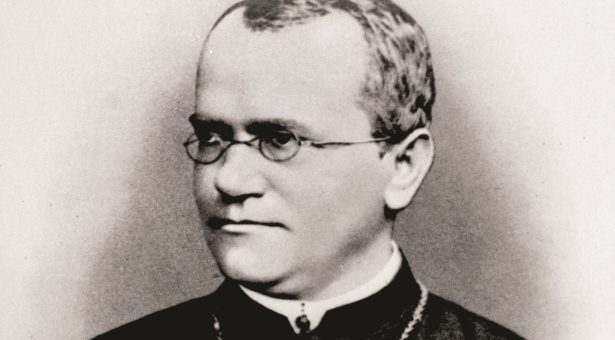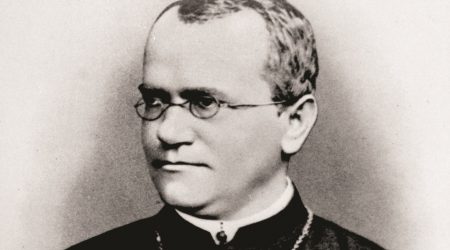Mendel and the culture of commemoration

This year, as part of their centenary celebrations, the Genetics Society teamed up with the Mendelianum (the museum dedicated to Mendel) and hosted International Mendel’s Day for the first time in the UK.
Mendel’s long series of crossing experiments on garden peas were commemorated in 2015 by an international genetics conference in the Mendel Museum of Masaryk University in Brno, two exhibitions in the Mendel Museum, and a third at the State Darwin Museum in Moscow, a full 150 years after he first read his paper ‘Experiments on plant hybridization’ to the natural history society in Brünn, now Brno in the Czech Republic.
These events all affirmed Mendel as the founding father of modern genetics. So, this seems then to be a good moment to reflect again on the ‘culture of commemoration’- how history of science is re-told and why ‘discovery narratives’ of the kind that surround Mendel are promoted.
The lionisation of Mendel in England began soon after the ‘rediscovery’ of his paper around 1900 by three European botanists: de Vries in Holland, Correns in Germany, and Tschermak in Austria. A year later, Cambridge University zoologist William Bateson organised the first English translation of Mendel’s paper for the Royal Horticultural Society and arranged for the translation to be reprinted with modifications on several occasions
Bateson also published one of the earliest biographical notices of Mendel in a preface to his book ‘Mendel’s Principles of Heredity: A defence’ (1909), from material he had collected on a pilgrimage to Brno in 1904.
Bateson’s narrative included many aspects of the history we’re now familiar with – the theme of neglected genius, the sensational rediscovery and confirmation of Mendel’s experiments, and the idea that if Darwin had been able to read Mendel the development of evolutionary science would have been very different. Versions of this story (without any historically informed reflection on the relationship between Darwin and Mendel) appear in the biology textbooks we offer to today’s schoolchildren and students.
For Bateson, commemoration was about bringing Mendel into general recognition. It was a calculated move in a battle he was engaged in with the English biometricians and other biological schools about the methods of biology and the causes of evolution.
In effect, Bateson built his reputation and career with the authority of Mendel behind him.
This relationship is nowhere better expressed than in the portrait of Bateson taken at the Darwin Museum in Moscow in 1925. We know the saying ‘standing on the shoulders of giants’ but in this photograph, the bust of Mendel is tellingly perched above William Bateson’s shoulders, with rows of domestic chickens and guinea pigs, the stock-in-trade of contemporary genetics experiments, arranged attractively in display cases behind him.
There is no sign in this image that by this point in his career Bateson had told his son Gregory (named after Mendel) that his life-long devotion to Mendelism had been a mistake; ‘a blind alley which would not throw any light on the differentiation of species, nor on evolution in general’ (Cock, 1980).
Commemoration is a collective endeavour that scientists engage in to build and sustain scientific disciplines (Haddad, 1999). Historians of science sometimes reinforce and at other times work against the discovery narratives that the act of commemoration produces.
Revisionist accounts of the history of Mendelism have revealed how much of the complexity of early 20th century biology gets forgotten in celebratory narratives. For example, we forget that Mendel’s three ‘re-discoverers’ had serious doubts about how widely Mendel’s laws applied; that within a year de Vries had turned away from Mendelian heredity; and that Tschermak’s interpretation of ‘Mendel’s principles’ differed significantly from Bateson’s.
When re-reading Mendel’s paper we should also be mindful of Ronald Fisher’s (not disinterested) conclusion that ‘Each generation, perhaps, found only in Mendel’s paper what it expected to find … [and] … ignored what did not confirm its own expectations’ (Fisher, 1936).
Mendel commemoration, of course, is not just for scientists or historians of science, it has had many other uses as well.
Bateson attended the first international gathering to memorialise Mendel in Brno in 1910 and was present at the unveiling of the Mendel statue, even giving one of the speeches. He witnessed the ceremonies being used to express German political power and commented that Mendel’s own Augustinian monastery and the Czechs were given a very minor role in the story being told. For example, the Abbot from the monastery was the only one present at the celebrations who had known Mendel personally, but was not included in the speeches. Meanwhile the pre-celebration meeting and exhibition of Mendel documents took place in the ‘German House’ not the monastery, and the monument’s inscription was in German alone (Cock, 1982).
Mendel’s story has also been used to promote science, or at least ‘free thinking’, over religion, notwithstanding his position as a friar and later Abbot within a monastic community.
Take the photograph of Mendel in the Darwin Museum in Moscow, which records a time when it was possible for Mendel to represent the glories of science, within a state cultural modernisation programme that had its museum sculptors busily replacing religious icons with statues of scientists. When genetics later fell out of favour in Russia, Mendel’s clerical position made him doubly suspect.
To me the most surprising history of Mendel commemoration is the one recently unearthed by Ronald Numbers (Numbers, 2015), which documents that for almost a century Mendel and Bateson have been celebrated as creationist heroes.
Mendel was embraced with enthusiasm by antievolutionists after Canadian-born school teacher George McCready Price began promoting Bateson’s statements against evolutionary theory to Christian fundamentalists. Though Bateson’s earlier books had said little about the relationship between Darwin and Mendel, his presidential address to the British Association for the Advancement of Science in Melbourne, Australia in 1914 began what became a long-standing creationist interest in Mendel. Price (bolstered with quotations from Bateson’s lecture) credited Mendelism with undermining Darwinism. If Mendelism allowed only for the varied re-assortment of hereditary characters already present there was no room for evolution. Later Bateson tried in vain to express his faith in evolution, to neutralise the coverage of his lectures that had provided fodder to the creationist camp. He failed, for Numbers shows that Mendel continues to be commemorated as a ‘creationist hero’ into the 21st century.
All of this shows that neither Mendel nor Bateson had control over the way their images or writings were represented. To borrow an insight from the Spanish author Javier Marίas, no-one achieves silence, not even after death.
It follows that studying the history of science is more than the interpretation of ‘landmark’ texts but must involve following ideas in circulation- studying both the people speaking on behalf of the dead scientists and the consumers of that information.
Further reading on Mendel
- 2019 International Mendel’s Day celebration
- MendelWeb
- Alan G. Cock (1980), ‘William Bateson’s Pilgrimages to Brno’, Brno Acta Musei Moraviae, Folia Mendeliana, 65: 243-250
- Alan G. Cock (1982), ‘Bateson’s impressions at the unveiling of the Mendel monument at Brno in 1910’, Brno Acta Musei Moraviae, Folia Mendeliana, 67: 217-223
- Ronald A. Fisher (1936), ‘Has Mendel’s work been rediscovered?’ Annals of Science, 1: 115-137
- George E. Haddad (1999), ‘Medicine and the culture of commemoration: representing Robert Koch’s discovery of the tubercle bacillus’, Osiris, 14: 118-37. [This classic paper has inspired historians of science and medicine to critically re-examine commemorative events. See also the other papers in this volume on the politics of collective memory]
- Javier Marίas (2006), Your Face Tomorrow. 1. Fever and Spear. Translated by M. J. Costa, London: Vintage Books, p. 4
- Ronald L. Numbers (2015), ‘Gregor Mendel: Creationist Hero’, Science and Education, 24: 115-23
- Robert C. Olby (1979), ‘Mendel No Mendelian’, History of Science, 17: 53–72
- Robert C. Olby (2000), ‘Horticulture: the font for the baptism of genetics’, Nature Reviews, Genetics, 1: 65-70. [A good summary of revisionist work on the early history of Mendel’s paper and the groups who were not receptive to Mendelism]
- Marsha L. Richmond (2006), ‘The 1909 Darwin Celebration. Re-examining Evolution in the Light of Mendel, Mutation and Meiosis’, Isis, 97: 447-484. [A behind-the-scenes look at how this Darwin commemorative event was stage managed, with valuable insights on contemporary attitudes to Mendel, Bateson, Mendelism and evolution]
- Jan Sapp (1990), ‘The Nine Lives of Gregor Mendel’, pp. 137-166 in ed. H. E. Le Grand, Experimental Enquiries (Kluwer Press: Netherlands). [An excellent survey of all the different ways Mendel has been portrayed and also available at Mendelweb].



